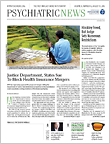As millions are being spent to find new medications or technologies to treat the manic symptoms of bipolar disorder, is it possible a relatively inexpensive and widely available solution already exists?
James Phelps, M.D., a psychiatrist who works at Samaritan Mental Health in Corvallis, Oregon, who has been a strong advocate for the use of blue light–blocking sunglasses as an aid to reduce bipolar mania, believes the answer is yes.
The concept behind light-blocking glasses is relatively straightforward: light therapy is known to reduce depressive symptoms in some patients, so researchers set out to determine if dark therapy might do the same for patients experiencing bipolar mania.
In 1998 clinicians at the National Institute of Mental Health tested this idea in a bipolar patient who was rapid cycling (alternating between manic and depressive episodes on a near daily basis) by placing the patient in a dark environment for 14 hours a day; the patient’s mood and sleep patterns stabilized quickly.
A few years later, Italian researchers conducted a pilot study with 16 bipolar inpatients and found that patients who had received the 14-hour dark therapy for three consecutive days in addition to their regular medication experienced a reduction in symptoms, required less medication, and were discharged earlier from the hospital.
While these studies pointed to the benefits of dark therapy, there were questions of how practical the technique might be outside of a hospital setting. A discovery in 2001 that the brain specifically uses the blue light wavelength to signal light/dark status suggested patients might also benefit from the “virtual darkness” created by blocking blue light.
Recognizing the tools to achieve this were already in place (welders have long made use of blue-blocking [also known as amber lenses] safety goggles to shield their eyes from intense blue welding sparks, and the goggles are known to increase visual clarity in the outdoors), Phelps began sending patients with bipolar disorder home with blue-blocking glasses.
According to Phelps, more than half of the bipolar patients he sees have reported improvements in manic symptoms, like insomnia, after using the blue-blocking glasses.
“They are generally skeptical at first, but interestingly, once they take them, they rarely give the glasses back,” he told Psychiatric News.
Sleep Hygiene Also Important Part of Therapy
Phelps acknowledged that without the exposure and imprimatur that a large clinical trial can bring, many psychiatrists are likely unaware about the potential benefits of blue-blocking glasses and/or may be unwilling to offer them to their patients. However, because blue-blocking glasses are already available on the market, it has been difficult to attract funding to explore them as a therapy.
Despite these challenges, the results of the first randomized, placebo-controlled trial of blue-blocking glasses as an additive bipolar therapy was published in May in Bipolar Disorders. The trial was small—with only 32 patients—but did show that patients who wore the glasses for seven days (between 6 p.m. and 8 a.m., including during sleep) saw a dramatic improvement in mania symptoms (scores on the Young Mania Rating Scale dropped an average of 14.1 points in the blue-blocking group compared with 1.7 points in the placebo glasses group).
Chris Aiken, M.D., director of the Mood Treatment Center at Wake Forest University School of Medicine and proponent of blue-blocking glasses, told Psychiatric News these findings validate the benefits often reported by patients using the glasses.
The evidence base surrounding blue-blocking glasses is not robust yet, he said, but there is growing evidence that targeting the light/dark cycle in these patients could offer long-term benefits.
“[W]henever I recommend the glasses, I always tie in a message about a healthy sleep lifestyle,” Aiken told Psychiatric News. “It’s important to remember that these glasses should be just one part of a comprehensive bipolar therapy that includes medications and/or psychotherapy as appropriate.”
Although there have been few adverse effects reported by patients using blue-blocking glasses (mild headaches are the most common issue reported), Aiken says there is a slight chance that mood may drop too far and trigger depression. (When this happened to a patient in the recent clinical study, the patient’s mood improved after stopping the eyeglass therapy for a couple of days.)
To help prevent these side effects, Aiken recommends that light-blocking glasses be coordinated with devices like dawn simulators (which can be devices or mobile apps that create a gradually increasing light as part of a morning alarm) to ensure bipolar patients maintain a normal sleep/wake schedule and get enough daylight during the first part of their day.
“I hope that more therapists will consider amber lenses not only as a cool new way to think about the treatment of mania, but also as a symbol for the bigger picture of chronotherapy,” Phelps said. “We get less light than we used to during the day and much more at night; and this lack of difference can weaken the circadian clock and lead to a host of issues.” ■
An abstract of “Blue-Blocking Glasses as Additive Treatment for Mania: A Randomized Placebo-Controlled Trial” can be accessed
here.

